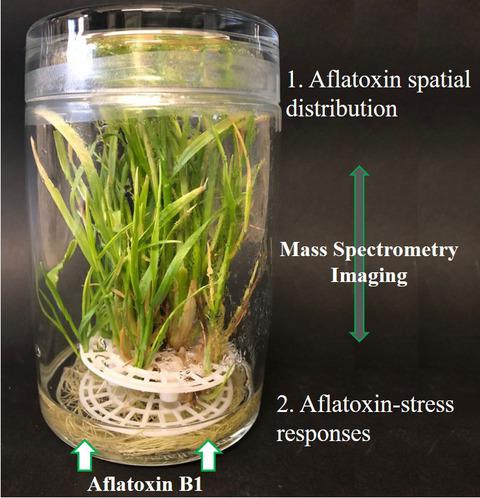Our official English website, www.x-mol.net, welcomes your
feedback! (Note: you will need to create a separate account there.)
Unveiling the spatial distribution of aflatoxin B1 and plant defense metabolites in maize using AP‐SMALDI mass spectrometry imaging
The Plant Journal ( IF 6.2 ) Pub Date : 2021-01-09 , DOI: 10.1111/tpj.15158 Laura Righetti 1, 2 , Dhaka Ram Bhandari 2 , Enrico Rolli 3 , Sara Tortorella 4 , Renato Bruni 1 , Chiara Dall'Asta 1 , Bernhard Spengler 2
The Plant Journal ( IF 6.2 ) Pub Date : 2021-01-09 , DOI: 10.1111/tpj.15158 Laura Righetti 1, 2 , Dhaka Ram Bhandari 2 , Enrico Rolli 3 , Sara Tortorella 4 , Renato Bruni 1 , Chiara Dall'Asta 1 , Bernhard Spengler 2
Affiliation

|
In order to cope with the presence of unfavorable compounds, plants can biotransform xenobiotics, translocate both parent compounds and metabolites, and perform compartmentation and segregation at the cellular or tissue level. Such a scenario also applies to mycotoxins, fungal secondary metabolites with a pre‐eminent role in plant infection. In this work, we aimed to describe the effect of the interplay between Zea mays (maize) and aflatoxin B1 (AFB1) at the tissue and organ level. To address this challenge, we used atmospheric pressure scanning microprobe matrix‐assisted laser desorption/ionization mass spectrometry imaging (AP‐SMALDI MSI) to investigate the biotransformation, localization and subsequent effects of AFB1 on primary and secondary metabolism of healthy maize plants, both in situ and from a metabolomics standpoint. High spatial resolution (5 µm) provided fine localization of AFB1, which was located within the root intercellular spaces, and co‐localized with its phase‐I metabolite aflatoxin M2. We provided a parallel visualization of maize metabolic changes, induced in different organs and tissues by an accumulation of AFB1. According to our untargeted metabolomics investigation, anthocyanin biosynthesis and chlorophyll metabolism in roots are most affected. The biosynthesis of these metabolites appears to be inhibited by AFB1 accumulation. On the other hand, metabolites found in above‐ground organs suggest that the presence of AFB1 may also activate the biochemical response in the absence of an actual fungal infection; indeed, several plant secondary metabolites known for their antimicrobial or antioxidant activities were localized in the outer tissues, such as phenylpropanoids, benzoxazinoids, phytohormones and lipids.
中文翻译:

使用 AP-SMALDI 质谱成像揭示玉米中黄曲霉毒素 B1 和植物防御代谢物的空间分布
为了应对不利化合物的存在,植物可以生物转化异生物质,转移母体化合物和代谢物,并在细胞或组织水平上进行区室和分离。这种情况也适用于真菌毒素,即在植物感染中起主要作用的真菌次级代谢产物。在这项工作中,我们旨在描述玉米(玉米)和黄曲霉毒素 B1 (AFB1) 在组织和器官水平上的相互作用。为了应对这一挑战,我们使用大气压扫描探针基质辅助激光解吸/电离质谱成像(AP-SMALDI MSI)调查生物转化,本地化和AFB1的对健康的玉米植物的初级和次级代谢后续效果,都在原地并且从代谢组学的角度来看。高空间分辨率 (5 µm) 提供了 AFB1 的精细定位,它位于根细胞间隙内,并与其 I 相代谢物黄曲霉毒素 M2 共定位。我们提供了由 AFB1 积累在不同器官和组织中诱导的玉米代谢变化的平行可视化。根据我们的非靶向代谢组学研究,根中的花青素生物合成和叶绿素代谢受到的影响最大。这些代谢物的生物合成似乎受到 AFB1 积累的抑制。另一方面,在地上器官中发现的代谢物表明,在没有实际真菌感染的情况下,AFB1 的存在也可能激活生化反应。的确,
更新日期:2021-01-09
中文翻译:

使用 AP-SMALDI 质谱成像揭示玉米中黄曲霉毒素 B1 和植物防御代谢物的空间分布
为了应对不利化合物的存在,植物可以生物转化异生物质,转移母体化合物和代谢物,并在细胞或组织水平上进行区室和分离。这种情况也适用于真菌毒素,即在植物感染中起主要作用的真菌次级代谢产物。在这项工作中,我们旨在描述玉米(玉米)和黄曲霉毒素 B1 (AFB1) 在组织和器官水平上的相互作用。为了应对这一挑战,我们使用大气压扫描探针基质辅助激光解吸/电离质谱成像(AP-SMALDI MSI)调查生物转化,本地化和AFB1的对健康的玉米植物的初级和次级代谢后续效果,都在原地并且从代谢组学的角度来看。高空间分辨率 (5 µm) 提供了 AFB1 的精细定位,它位于根细胞间隙内,并与其 I 相代谢物黄曲霉毒素 M2 共定位。我们提供了由 AFB1 积累在不同器官和组织中诱导的玉米代谢变化的平行可视化。根据我们的非靶向代谢组学研究,根中的花青素生物合成和叶绿素代谢受到的影响最大。这些代谢物的生物合成似乎受到 AFB1 积累的抑制。另一方面,在地上器官中发现的代谢物表明,在没有实际真菌感染的情况下,AFB1 的存在也可能激活生化反应。的确,











































 京公网安备 11010802027423号
京公网安备 11010802027423号